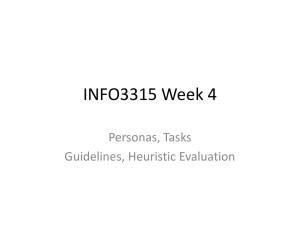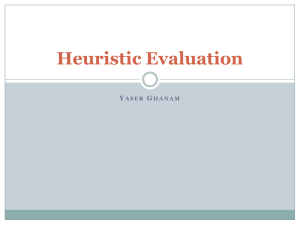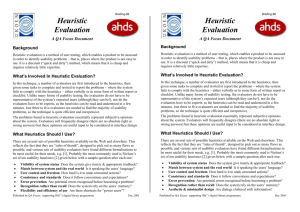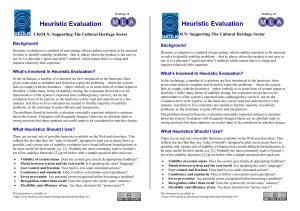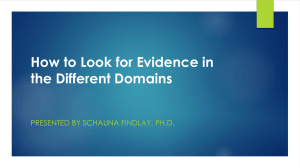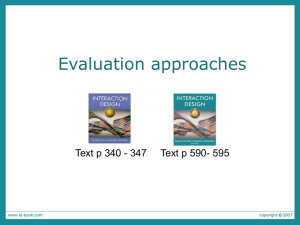heuristic-evaluation
advertisement
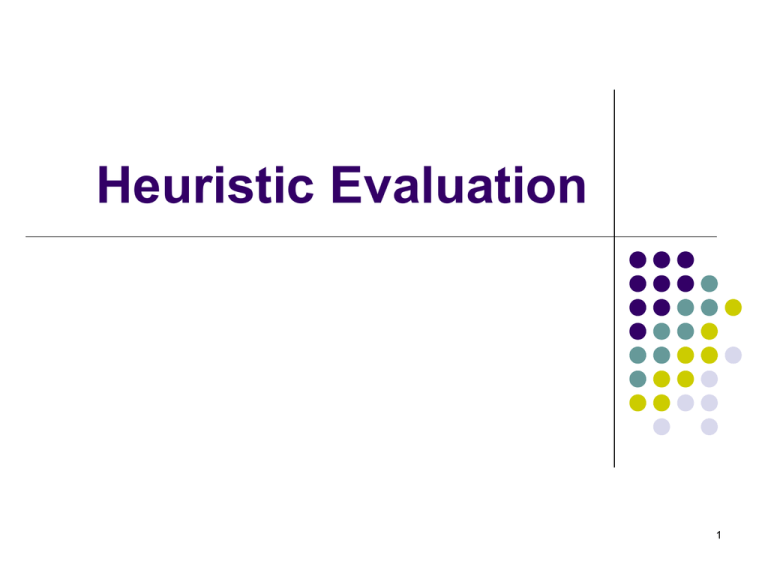
Heuristic Evaluation 1 Interface Hall of Shame or Fame? Standard MS calculator on all Win95/98/NT/2000/XP 2 Interface Hall of Shame! What is the empty button above MC for? Can’t resize Blue for numbers! goes against all we know hard to focus on combined with red eye strain 3 Outline Discount usability engineering Heuristic evaluation overview Administrivia Heuristics How to perform a HE HE vs. user testing How well does HE work 4 Discount Usability Engineering (?) Cheap Fast no special labs or equipment needed the more careful you are, the better it gets on order of 1 day to apply standard usability testing may take a week Easy to use can be taught in 2-4 hours 5 Examples Walkthroughs Low-fi prototyping Action analysis put yourself in the shoes of a user like a code walkthrough GOMS (add times to formal action analysis) On-line, remote usability tests Heuristic evaluation 6 Heuristic Evaluation Developed by Jakob Nielsen Helps find usability problems in a UI design Small set (3-5) of evaluators examine UI independently check for compliance with usability principles (“heuristics”) different evaluators will find different problems evaluators only communicate afterwards findings are then aggregated Can perform on working UI or on sketches I’ve found in this class it works better on working UI 7 Why Multiple Evaluators? Every evaluator doesn’t find every problem Good evaluators find both easy & hard ones 8 Heuristic Evaluation Process Evaluators go through UI several times Usability principles inspect various dialogue elements compare with list of usability principles consider other principles/results that come to mind Nielsen’s “heuristics” supplementary list of category-specific heuristics competitive analysis & user testing of existing products Use violations to redesign/fix problems 9 Heuristics (original) H1-1: Simple & natural dialog H1-2: Speak the users’ language H1-3: Minimize users’ memory load H1-4: Consistency H1-5: Feedback H1-6: Clearly marked exits H1-7: Shortcuts H1-8: Precise & constructive error messages H1-9: Prevent errors H1-10: Help and documentation 10 Heuristics (revised set) searching database for matches H2-1: Visibility of system status keep users informed about what is going on example: pay attention to response time 0.1 sec: no special indicators needed, why? 1.0 sec: user tends to lose track of data 10 sec: max. duration if user to stay focused on action for longer delays, use percent-done progress bars 11 Heuristics (cont.) Bad example: Mac desktop Dragging disk to trash should delete it, not eject it H2-2: Match between system & real world speak the users’ language follow real world conventions 12 Heuristics (cont.) Wizards H2-3: User control & freedom “exits” for mistaken choices, undo, redo don’t force down fixed paths like that BART machine… must respond to Q before going to next for infrequent tasks (e.g., modem config.) not for common tasks good for beginners have 2 versions (WinZip) 13 Heuristics (cont.) H2-4: Consistency & standards 14 Heuristics (cont.) MS Web Pub. Wiz. Before dialing asks for id & password When connecting asks again for id & pw H2-5: Error prevention H2-6: Recognition rather than recall make objects, actions, options, & directions visible or easily retrievable 15 Heuristics (cont.) Edit Cut Copy Paste H2-7: Flexibility and efficiency of use accelerators for experts (e.g., gestures, kb shortcuts) allow users to tailor frequent actions (e.g., macros) 16 Heuristics (cont.) H2-8: Aesthetic and minimalist design no irrelevant information in dialogues 17 Heuristics (cont.) H2-9: Help users recognize, diagnose, and recover from errors error messages in plain language precisely indicate the problem constructively suggest a solution 18 Heuristics (cont.) H2-10: Help and documentation easy to search focused on the user’s task list concrete steps to carry out not too large 19 Administrivia Please turn in the homework it must also be online Wai-ling will help get you info on how to move to our Web server by next week We will be webcasting by next Monday Other questions? 20 Phases of Heuristic Evaluation 1) Pre-evaluation training give evaluators needed domain knowledge and information on the scenario 2) Evaluation individuals evaluate and then aggregate results 3) Severity rating determine how severe each problem is (priority) can do this first individually & then as a group 4) Debriefing discuss the outcome with design team 21 How to Perform Evaluation At least two passes for each evaluator If system is walk-up-and-use or evaluators are domain experts, no assistance needed first to get feel for flow and scope of system second to focus on specific elements otherwise might supply evaluators with scenarios Each evaluator produces list of problems explain why with reference to heuristic or other information be specific and list each problem separately 22 Examples Can’t copy info from one window to another violates “Minimize the users’ memory load” (H1-3) fix: allow copying Typography uses mix of upper/lower case formats and fonts violates “Consistency and standards” (H2-4) slows users down probably wouldn’t be found by user testing fix: pick a single format for entire interface 23 How to Perform Evaluation Why separate listings for each violation? risk of repeating problematic aspect may not be possible to fix all problems Where problems may be found single location in UI two or more locations that need to be compared problem with overall structure of UI something that is missing hard w/ paper prototypes so work extra hard on those note: sometimes features are implied by design docs and just haven’t been “implemented” – relax on those 24 Severity Rating Used to allocate resources to fix problems Estimates of need for more usability efforts Combination of frequency impact persistence (one time or repeating) Should be calculated after all evals. are in Should be done independently by all judges 25 Severity Ratings (cont.) 0 - don’t agree that this is a usability problem 1 - cosmetic problem 2 - minor usability problem 3 - major usability problem; important to fix 4 - usability catastrophe; imperative to fix 26 Debriefing Conduct with evaluators, observers, and development team members Discuss general characteristics of UI Suggest potential improvements to address major usability problems Dev. team rates how hard things are to fix Make it a brainstorming session little criticism until end of session 27 Severity Ratings Example 1. [H1-4 Consistency] [Severity 3][Fix 0] The interface used the string "Save" on the first screen for saving the user's file, but used the string "Write file" on the second screen. Users may be confused by this different terminology for the same function. 28 HE vs. User Testing HE is much faster HE doesn’t require interpreting user’s actions User testing is far more accurate (by def.) 1-2 hours each evaluator vs. days-weeks takes into account actual users and tasks HE may miss problems & find “false positives” Good to alternate between HE & user testing find different problems don’t waste participants 29 Results of Using HE Discount: benefit-cost ratio of 48 [Nielsen94] cost was $10,500 for benefit of $500,000 value of each problem ~15K (Nielsen & Landauer) how might we calculate this value? in-house -> productivity; open market -> sales customer calls to your customer service center Correlation between severity & finding w/ HE 30 Results of Using HE (cont.) Single evaluator achieves poor results only finds 35% of usability problems 5 evaluators find ~ 75% of usability problems why not more evaluators???? 10? 20? adding evaluators costs more many evaluators won’t find many more problems 31 Decreasing Returns problems found benefits / cost Caveat: graphs for a specific example 32 Simple HE Homework Given a poorly designed web page Find at least 15 distinct heuristic violations number the violations on the diagram list violation with number on another sheet give a solution to fix Individual assignment Due next Monday in class 33 Summary Heuristic evaluation is a discount method Have evaluators go through the UI twice Ask them to see if it complies with heuristics note where it doesn’t and say why Combine the findings from 3 to 5 evaluators Have evaluators independently rate severity Discuss problems with design team Alternate with user testing 34
